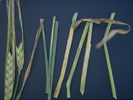International Database for Barley Genes and Barley Genetic Stocks
BGS 301, Fragile stem 1, fst1
Stock number: BGS 301
Locus name: Fragile stem 1
Locus symbol: fst1
Previous nomenclature and gene symbolization:
Fragile stem = fs (6).
Inheritance:
Monofactorial recessive (6).
Located in chromosome 5HL (5, 6); fst1.a is about 24.3 cM proximal from the srh1 (short rachilla hair 1) locus (3, 4, 7). fst1.a is associated with SNP markers 2_0367 to 2_0850 (positions 116.66 to 157.13 cM) in 5H bins 07 to 09 of the Bowman backcross-derived line BW372 (1); fst1.d is associated with SNP markers 3_0314 to 2_0850 (positions ≈136 to 157.13 cM) in 5H bins 08 to 09 of the Bowman backcross-derived line BW373 (1).
Located in chromosome 5HL (5, 6); fst1.a is about 24.3 cM proximal from the srh1 (short rachilla hair 1) locus (3, 4, 7). fst1.a is associated with SNP markers 2_0367 to 2_0850 (positions 116.66 to 157.13 cM) in 5H bins 07 to 09 of the Bowman backcross-derived line BW372 (1); fst1.d is associated with SNP markers 3_0314 to 2_0850 (positions ≈136 to 157.13 cM) in 5H bins 08 to 09 of the Bowman backcross-derived line BW373 (1).
Description:
Leaves and stems of mutant plants are easily broken when physical bent. This extraordinary fragility is exhibited even after maturity. Generally, stems are more flexible than in normal plants, and straw breakage prior to harvest is rare (6). In the Bowman backcross-derived line for fst1.a (BW372), nodding of the culms is frequent and forage yield is reduced. In Bowman backcross-derived line for fst1.d (BW373), culms are less fragile and nodding is much less (2). BW372 (fst1.a) plants were 10 to 15% shorter and yields were about 50% lower. Kernels of BW372 weight about 10% less than those of Bowman. BW373 (fst1.d) plants were similar to Bowman plants for all traits except for easily broken culms (2).



Origin of mutant:
A spontaneous mutant in an unknown cultivar and named Kamairazu, which means "sickle not needed to harvest" (6).
Mutational events:
fst1.a in Kamairazu (OUL008, GSHO 629) (6); fst1.d in a Western Plant Breeders selection (2).
Mutant used for description and seed stocks:
fst1.a in Kamairazu (GSHO 629, GSHO 858, OUL008); fst1.a in Bowman (PI 483237, NGB 22812)*5 (GSHO 2100); fst1.a in Bowman*6 (BW372, NGB 20611); fst1.d in Bowman*7 (GSHO 2101, BW373, NGB 20612).
References:
1.Druka, A., J. Franckowiak, U. Lundqvist, N. Bonar, J. Alexander, K. Houston, S. Radovic, F. Shahinnia, V. Vendramin, M. Morgante, N. Stein, and R. Waugh. 2011. Genetic dissection of barley morphology and development. Plant Physiol. 155:617-627.
2. Franckowiak, J.D. (Unpublished).
3. Hayashi, J., I. Moriya, and R. Takahashi. 1983. A further study on linkage of the "dusky" mutant, dsk. Barley Genet. Newsl. 13:42-44.
4. Jensen, J. 1981. Construction of a barley chromosome 7 linkage map. p. 927-939. In M.J.C. Asher, R.P. Ellis, A.M. Hayter, and R.N.H. Whitehouse (eds.) Barley Genetics IV. Proc. Fourth Int. Barley Genet. Symp., Edinburgh. Edinburgh Univ. Press, Edinburgh.
5. Ramage, R.T., and C.A. Suneson. 1961. Translocation-gene linkages on barley chromosome 7. Crop Sci. 1:319-320.
6. Takahashi, R., J. Yamamoto, S. Yasuda, and Y. Itano. 1953. Inheritance and linkage studies in barley. Ber. Ohara Inst. landw. Forsch. 10:29-52.
7. Yoshimi, R., and T. Konishi. 1995. Linkage analysis of several isozyme loci in barley. Barley Genet. Newsl. 24:35-37.
2. Franckowiak, J.D. (Unpublished).
3. Hayashi, J., I. Moriya, and R. Takahashi. 1983. A further study on linkage of the "dusky" mutant, dsk. Barley Genet. Newsl. 13:42-44.
4. Jensen, J. 1981. Construction of a barley chromosome 7 linkage map. p. 927-939. In M.J.C. Asher, R.P. Ellis, A.M. Hayter, and R.N.H. Whitehouse (eds.) Barley Genetics IV. Proc. Fourth Int. Barley Genet. Symp., Edinburgh. Edinburgh Univ. Press, Edinburgh.
5. Ramage, R.T., and C.A. Suneson. 1961. Translocation-gene linkages on barley chromosome 7. Crop Sci. 1:319-320.
6. Takahashi, R., J. Yamamoto, S. Yasuda, and Y. Itano. 1953. Inheritance and linkage studies in barley. Ber. Ohara Inst. landw. Forsch. 10:29-52.
7. Yoshimi, R., and T. Konishi. 1995. Linkage analysis of several isozyme loci in barley. Barley Genet. Newsl. 24:35-37.
Prepared:
T.E. Haus and T. Tsuchiya. 1971. Barley Genet. Newsl. 1:160.
Revised:
J.D. Franckowiak and T. Konishi. 1997. Barley Genet. Newsl. 26:252.
J.D. Franckowiak. 2018. Barley Genet. Newsl. 48:122-123.
J.D. Franckowiak. 2018. Barley Genet. Newsl. 48:122-123.
